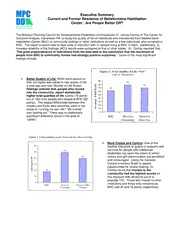
Current and Former Residents of Bellefontaine Habilitation Center Survey Executive Summary Report 2007 PDF
Preview Current and Former Residents of Bellefontaine Habilitation Center Survey Executive Summary Report 2007
Executive Summary Current and Former Residents of Bellefontaine Habilitation Center: Are People Better Off? ~JilOIHi Pion,w,g WlHKl1 Fot D~•elopmrn1al Oi1ab,J,tir, The Missouri Planning Council for Developmental Disabilities commissioned Dr. James Conroy of The Center for Outcome Analysis, Havertown PA, to study the quality of life of individuals who transitioned from Bellefontaine Habilitation Center (BHC) to community settings or other institutions as well as a few individuals who remained in BHC. The report involved face-to-face visits in mid-2007 with 41 people living at BHC in 2005. Additionally, to increase reliability of the findings, MO’s results were compared to that of other states. Dr. Conroy reported that, “The great preponderance of indications from the data lead to the conclusion that the movement of people from BHC to community homes had strongly positive outcomes.” Some of the most significant findings include: Figure 1: Total Qualit~· of Lifr ·'. ow'" (out of I 00 point ) • Better Quality of Life: When each person or their surrogate was asked to rate quality of life 78 t: a year ago and now (Quality of Life Scale), 80 70 findings indicate that, people who moved ,_,,._, 70 62 into the community, report statistically 60 ~ higher total qualities of life scores (78 points ~ 50 out of 100) than people who stayed at BHC (62 ,.. 40 ::i;: points). The largest differences between the i= 30 movers and those who remained, were in the ~ 20 ,.,. 10 areas of “running my own life,” “life overall,” and “getting out.” There was no statistically 0 +---'-- ---L-~--'---'--~----L----'-~ significant difference found in the area of BHC Moved to oved to “safety”. Community Olher Inst Figure 3: Cholccmaking calc cores for thc Three Croups • More Choice and Control: One of the 60 leading indicators of quality in supports and services for people with intellectual -19 50 disabilities has been the extent to which = -10 choice and self-determination are permitted 40 - and encouraged. Using the Decision = Control Inventory Scale to assess § 30 ,,.=... opportunities for choice-making, Dr. & 10 Jg Conroy found that movers to the community had the highest scores on 10 this measure with 49 points out of a possible 100. Those who moved to other 0 institutions and those who remained at BHC 1o,'ed lo 1ovcd to O0rr Comrn.miiy Tnslitution BHC had 40 and 18 points respectively. Figure 4: lnLegrative .\cth·ities Per lonlh for the Thret' Groups Integrative cfiyjtje • Getting Out More: Integration of people with 30 developmental disabilities is one of the gold standards of quality of services. This involves a 24 25 simple count of how often people “get out” (going to a movie, restaurant, visiting with friends, etc.) 20 ~ each month. The findings were “very statistically "" significant” with people in the community getting ::~.. 15 out 24 times per month compared to those in c~,., BHC being out 9 times per month. The national _;j JO 9 8 average for non-disabled citizens is about 50 such 5 activities per month. 0 BHC Mm'Cd 10 Moved to Olh-,r Connmiily lrntilulion Figure 7: Prr,gre --To\\ard lndh·ldual Program Goals for Two Grriup· 80 74 70 • Making More Progress in the Community: 60 The Progress Toward Individual Goals Scale 60 rated progress toward the top five goals for § so each individual surveyed. The movers to s 0. ,- community showed significant differences in 0 40 attained goals of 74 per 100 for community ell ~3 30 movers, as compared to 60 per 100 for BHC en residents. Those who moved to other institutions could not be assessed. 20 10 0 BHC M<>1od to Commlrity The data clearly implied that the movers to community homes benefited the most from all the changes. Dr. Conroy reports that, in nearly every comparison the researchers could perform, the quality of life and the changes in the quality of life, were superior for the people who moved from Bellefontaine to community homes. The Missouri findings were compared to data from several other large-scale studies, using the exact same instruments, and the researchers found that the results obtained in other states are compellingly similar to those found in this study. This heightens the confidence in the Missouri work and confirms the strongly positive outcomes for those who moved to the community. Dr. Conroy and his research team encouraged Missouri, as well as society in general, to weigh the public costs of institutions in making decisions about services and supports for people with developmental disabilities in the future. For the complete report, please visit the Missouri Planning Council for Developmental Disabilities’ web site: mpcdd.com or call 800-500-7878.
